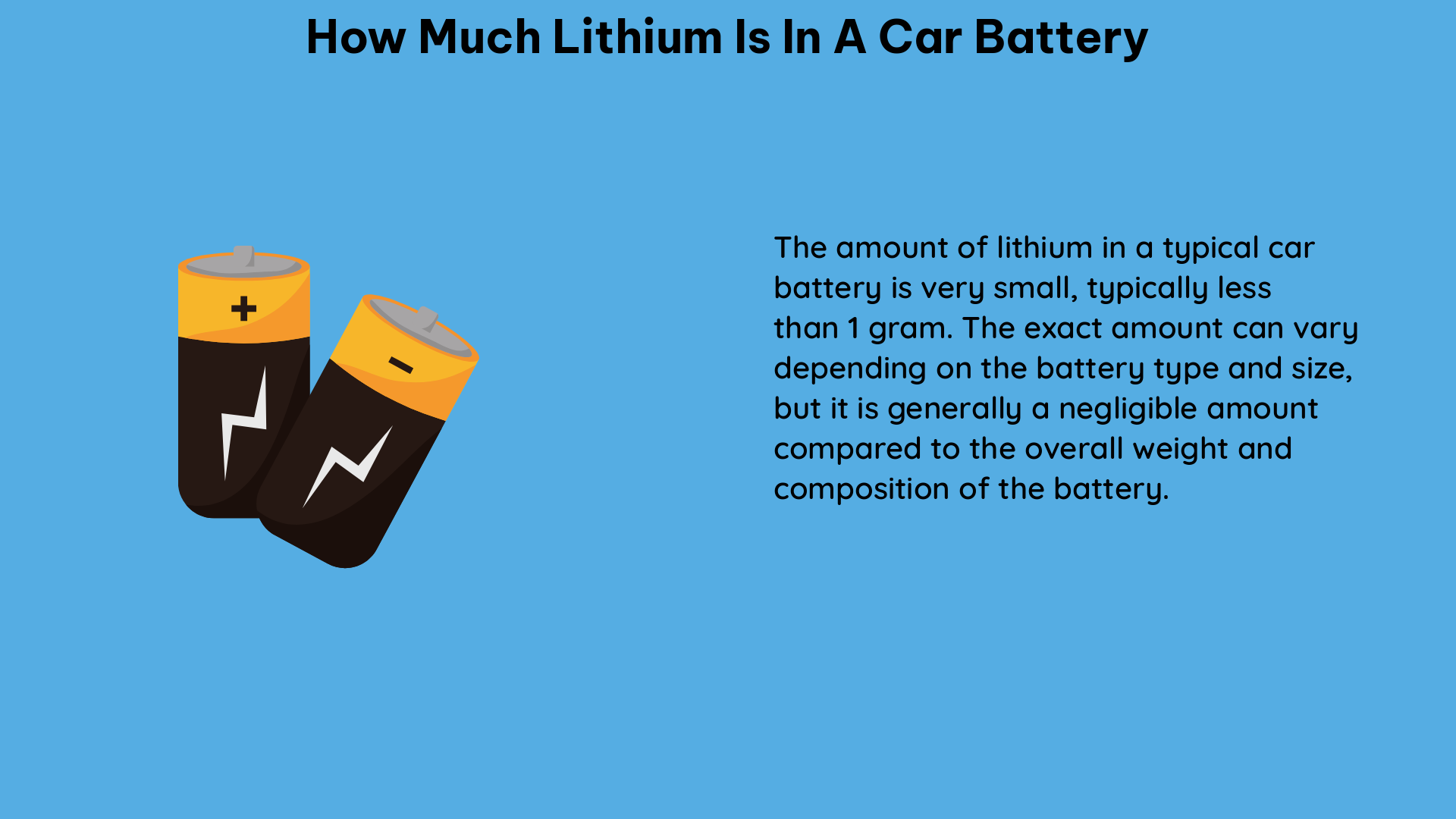The amount of lithium in a car battery can vary depending on the battery’s size and type, but a typical 50 kWh battery would contain around 8 kg of lithium metal or 25 kg of lithium carbonate equivalent. Understanding the precise lithium content in a car battery is crucial for various reasons, including battery recycling, supply chain management, and environmental impact assessments.
Lithium Content in Car Batteries
-
Lithium Metal Content: A typical car battery contains around 160 grams of lithium metal per kilowatt-hour (kWh) of battery capacity. For example, a 50 kWh battery, such as the one found in the Tesla Model 3 Long Range, would contain approximately 8 kg of lithium metal.
-
Lithium Carbonate Equivalent (LCE) Content: The amount of lithium in a battery can also be expressed in terms of lithium carbonate equivalent (LCE), which is a more commonly traded form of lithium in the industry. The conversion factor between lithium metal and LCE is approximately 3.1, meaning that the same 50 kWh battery would contain around 25 kg of lithium carbonate equivalent.
-
Variation in Lithium Content: The amount of lithium in a battery can vary depending on the specific chemistry and design of the battery. For example, some batteries may use lithium iron phosphate (LiFePO4) or lithium manganese oxide (LiMn2O4) instead of the more common lithium nickel manganese cobalt oxide (LiNiMnCoO2) chemistry, which can affect the amount of lithium required.
Factors Affecting Lithium Content in Car Batteries

-
Battery Capacity: The lithium content in a car battery is directly proportional to the battery’s capacity. Larger batteries, such as those found in electric vehicles, will contain more lithium than smaller batteries used in hybrid or conventional vehicles.
-
Battery Chemistry: The choice of battery chemistry can impact the lithium content. Batteries with different cathode materials, such as LiFePO4 or LiMn2O4, may require less lithium compared to LiNiMnCoO2 batteries.
-
Battery Design: The specific design of the battery pack, including the number and arrangement of individual cells, can also affect the overall lithium content.
Lithium-ion Battery Pack Assembly
When assembling a lithium-ion battery pack for DIY or other applications, it is crucial to use high-quality lithium-ion cells that have been specifically designed for use in battery packs. These cells are typically available in standard sizes, such as 18650 or 21700, and can be purchased from reputable suppliers.
-
Cell Selection: Choose lithium-ion cells with the appropriate capacity, discharge rate, and safety features for your application.
-
Battery Management System (BMS): Implement a BMS to monitor and control the pack’s voltage, current, and temperature, ensuring safe and efficient operation.
-
Safety Precautions: Follow proper safety procedures when assembling the battery pack, including using appropriate personal protective equipment (PPE) and following manufacturer guidelines.
-
Balancing and Charging: Ensure that the individual cells in the pack are balanced and charged correctly to maintain optimal performance and longevity.
Conclusion
The amount of lithium in a car battery can vary significantly depending on the battery’s size, type, and chemistry. Understanding the precise lithium content is essential for various applications, including battery recycling, supply chain management, and environmental impact assessments. When assembling a lithium-ion battery pack, it is crucial to use high-quality cells and follow proper safety procedures to ensure safe and reliable operation.
References
- How Much Lithium is in a Li-Ion Vehicle Battery? – LinkedIn, https://www.linkedin.com/pulse/how-much-lithium-li-ion-vehicle-battery-paul-martin/
- Lithium-ion battery data and where to find it – ScienceDirect, https://www.sciencedirect.com/science/article/pii/S2666546821000355
- Mapping the total lithium inventory of Li-ion batteries – ScienceDirect, https://www.sciencedirect.com/science/article/abs/pii/S2542435123004518
- Quantitative Analysis of Lithium-Ion Battery Capacity Prediction via Adaptive Bathtub-Shaped Function, https://www.mdpi.com/1996-1073/6/6/3082
- How much CO2 is emitted by manufacturing batteries? | MIT Climate, https://climate.mit.edu/ask-mit/how-much-co2-emitted-manufacturing-batteries

The lambdageeks.com Core SME Team is a group of experienced subject matter experts from diverse scientific and technical fields including Physics, Chemistry, Technology,Electronics & Electrical Engineering, Automotive, Mechanical Engineering. Our team collaborates to create high-quality, well-researched articles on a wide range of science and technology topics for the lambdageeks.com website.
All Our Senior SME are having more than 7 Years of experience in the respective fields . They are either Working Industry Professionals or assocaited With different Universities. Refer Our Authors Page to get to know About our Core SMEs.